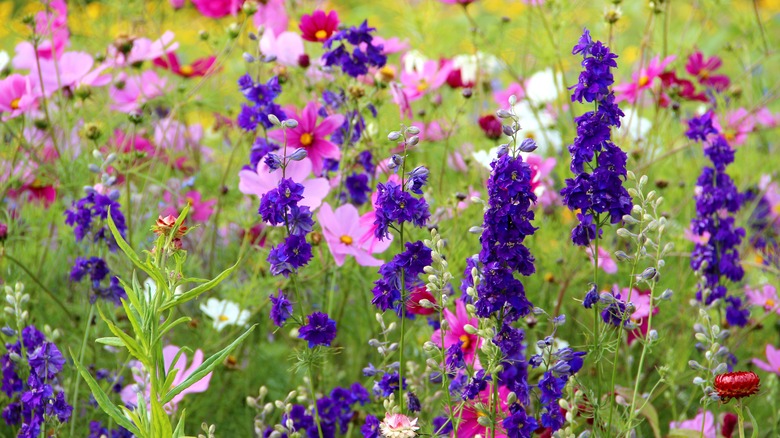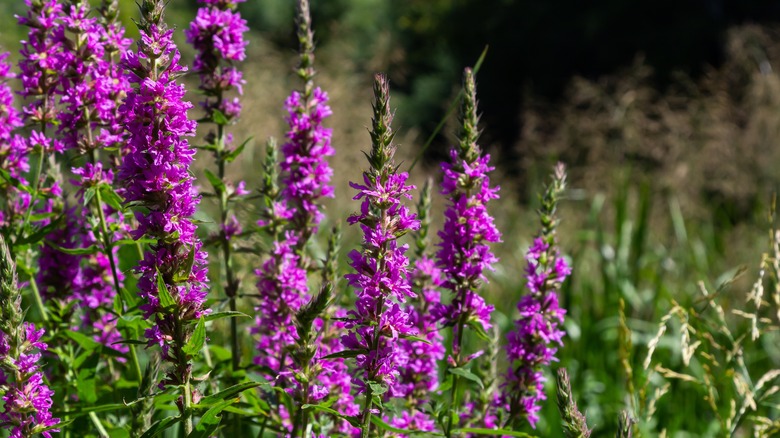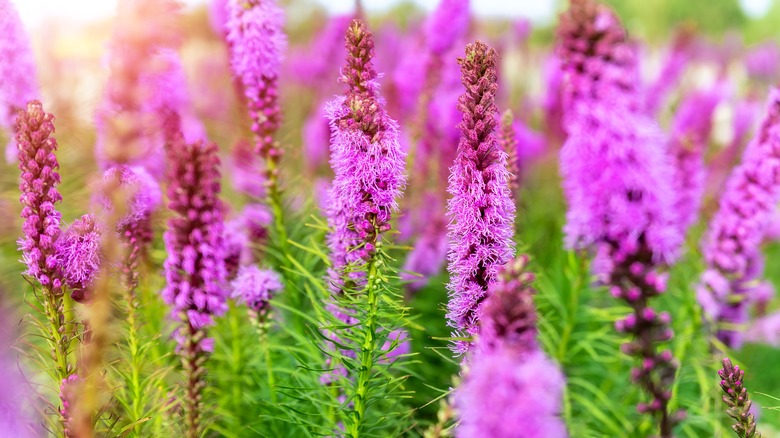The Vibrant Purple Flowering Plant That's Actually A Noxious Weed
Few things are more beautiful than a garden full of tall spikes of purple flowers. Unfortunately, not all flora is beneficial or beautiful, and some of it can actually be invasive. While many violet-colored blooms are perfect for gardens across the United States, purple loosestrife (Lythrum salicaria) is not one of them. Despite its beauty, the plant is such a problem that most states have made it illegal to sell. Luckily, with effort, it's possible to identify and remove purple loosestrife and replace it with native plants and other non-invasive species.
Purple loosestrife made its way from Eurasia to North America some time in the mid-1800s, and it can now be found in every U.S. state except Hawaii and Florida. Purple loosestrife is especially ubiquitous in the northeastern U.S. and in southern parts of Canada, where its ability to outcompete native species and clog irrigation wreaks havoc on native ecosystems and agriculture alike. Purple loosestrife resembles several types of plants from a distance, but a close examination should help you to identify it more accurately. The plant has a square and often branching stem with hairy lance-shaped leaves. Once it flowers, the prolific blooms are generally pink or purple, creating a long spike of flowers at the end of their stems.
How to remove purple loosestrife
Because purple loosestrife can spread so quickly and aggressively, both by seed and by rhizomes, it must be rapidly eliminated. In states where purple loosestrife is on the noxious weed list, this isn't just the right thing to do; it's the law. Fortunately, the earlier you catch a purple loosestrife problem, the easier it is to deal with. If you've confirmed that a plant or patch of plants growing on your property is purple loosestrife, then it's best to remove the invasive plant species from your lawn and garden immediately. Ideally, you should do this before they begin flowering and setting seed in late summer.
For small patches of purple loosestrife, manually digging up the plants is the best course of action. Be sure to remove all roots and rhizomes as well. For larger problems, herbicides may be needed. Because purple loosestrife seeds can survive in the ground for several years, you should stay on top of mowing or weeding out any seedlings. While it may feel wrong to bag and throw out purple loosestrife instead of composting it, this is the best strategy. Adding these common, noxious weeds to your compost pile could result in the seeds and rhizomes not fully breaking down and invading other areas of your garden.
Native alternatives to purple loosestrife
While you may occasionally see purple loosestrife for sale that is supposed to be sterile, it's best to steer clear of this. Many gardeners have found out the hard way that even plants labeled as sterile can sometimes produce seeds. Avoiding purple loosestrife doesn't mean you can't enjoy massive purple flower stalks though. There are a variety of beautiful perennials that bloom with gorgeous purple flowers.
For example, the similar-looking blazing star (Liatris spicata) provides drama and height, grows well in zones 3 through 8, and is native to the eastern United States. Bee balm (Monarda fistulosa) is a great native option for drier areas and is hardy in zones 3 through 9. In addition to filling your garden with purple flowers, it also attracts pollinators like bees, butterflies, and hummingbirds. Another fantastic native purple flower is baptisia (Baptisia spp.). It thrives in drier soil and can handle both full and part sun locations. Hardy in zones 3 through 8, it's a great option for drought tolerant butterfly gardens. Tall larkspur (Delphinium exaltatum) is another beautiful native plant that adds height and purple flowers to gardens. It is a hardy perennial in zones 4 through 7 and is a U.S. native. Despite its beauty, gardeners with children or pets should be aware that tall larkspur is quite poisonous and, in severe cases, can even cause death.


